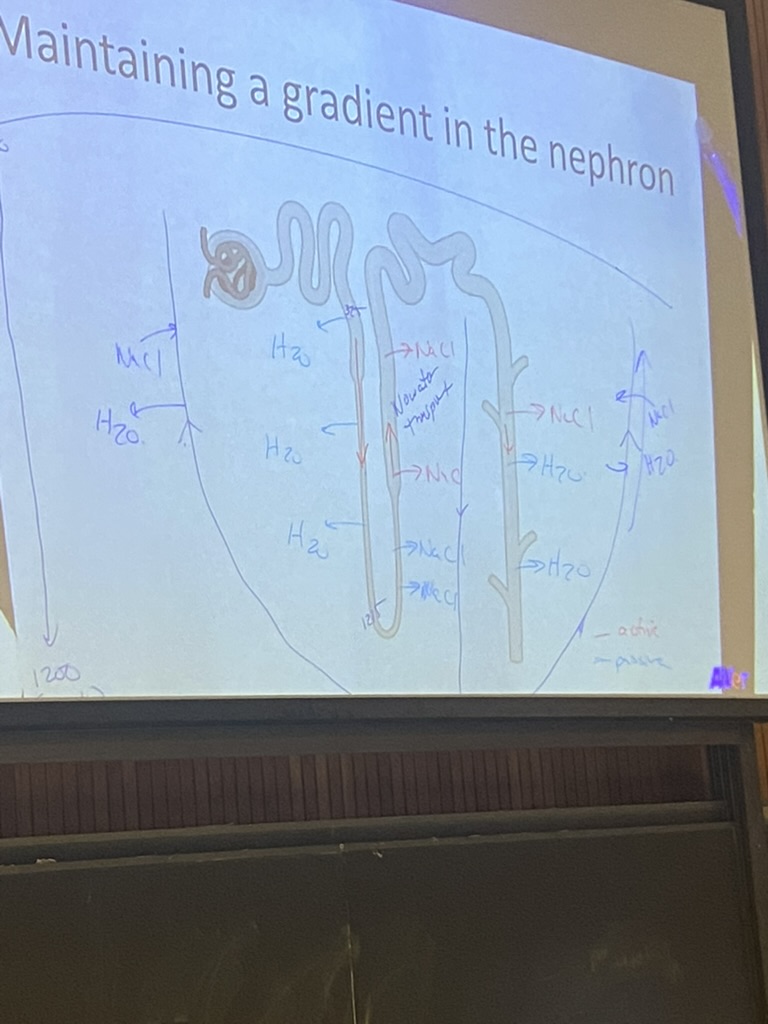EXAM 4 LO
Define sexual and asexual reproduction.
Sexual Reproduction: Fusion of haploid gametes (egg, sperm) into a diploid zygote
Asexual Reproduction: Cloning of an organism, no genetic recombination
All animals reproduce sexually just some reproduce asexually!
Explore different modes of asexual reproduction.
Budding: Fragmentation of parts from an original organism developing into new individuals
Ex. Corals, Hydras
(Binary)Fission: When an organism splits into two or more separate individuals
Ex. Anemones, Flatworms
Parthenogenesis: Offspring develops from unfertilized eggs
Ex. Aphids
Haplodiploidy: Males are haploid (unfertilized) and Females are diploid (fertilized)
Ex. Bees
Explain the two-fold cost of sex.
In a population of females reproducing asexually everyone can produce young
In a population of females reproducing sexually only females can produce young
In summary the asexual population can produce 2X as much as the sexual population
Understand why asexual reproduction is less common.
Asexual reproduction is less common and is usually brought about by factors such as:
Density, Length of Day, and the Availability of Resources
Parasites frequent populations with a more common genotype aka asexual host populations leading to widespread decimations and deaths
Asexual hosts can only rely on random mutation to adapt to evolutionary changes regarding parasites etc.
Sexual populations on the other hand have genetic recombination meaning they can withstand and undergo evolutionary resistance to certain parasites etc.
Compare internal and external fertilization.
Internal fertilization occurs within or near a female reproductive tract
Courtship/mating behaviors usually follow
Increased parental care
Internal gestation or embryonic development in egg
Requires compatible morphology
External fertilization occurs in the environment where a female releases eggs and male sperm can fertilize them
Requires a moist environment for aided sperm mobility
Synchronous spawning is the reproduction btw. many individuals which is common in external fertilization
Factors that can be disrupted with this is:
Timing
Environmental Cues
Chemical Signs
Courtship
Examine adaptive benefits of unusual reproductive strategies.
Sperm Removal: Specialized structures males can have which removes the sperm of other males in female repro. tract
Sperm Storage: Where females can store sperm in spermatheca until the female will choose a certain one best suited for either environment or fitness levels
Sperm Plug: Where males secrete a special substance blocking the female repro. tract from other males to put sperm into, this is not temporary but prevents females from mating with males immediately after giving preference to first male.
Sex Reversal: When an organism can change their sex for increased mating success
Compare how animals acquire food
They can acquire food through various methods such as:
Ingestion: Intake of food
Digestion: Breakdown of food
Absorption: Nutrients are taken up from food
Elimination: Waste is excreted
The various feeding methods are:
Filter feeding: Straining small food particles from substances
Substrate feeding: Living in or on the food source
Fluid feeding: Sucking nutrient rich foods from host
Bulk feeding: Consuming large particles of food
Review the digestive system in mammals
All mammals besides sponges have extracellular digestion
Gastrovascular Cavity:
The site for both digestion and absorption of food, single opening for ingestion and secretion
Mouth and anus is one opening
Digestive Tract:
Organized into compartments for absorption, digestion, and storage
Mouth and anus are two separate openings
Ex. Humans, Mammals
Bacteria, Archaea, and some protists have intracellular digestion
Human Digestive System
Stomach/Oral Cavity
The mouth enacts ingestion and carbohydrate digestion (mechanical digestion is chewing and chemical digestion in saliva)
The stomach functions in storage and protein digestion with gastric juices (chemical digestion)
Intestines/Excretion
Small Intestines: main site for digestion and absorption of nutrients using enzymes and microvilli
Large Intestines: functions in water reabsorption, symbiotic bacteria assist in digestion
Rectum/Anus: the a site for storage and waste excretion
Examine different modes of digestion: mechanical, chemical, and by symbionts
Mechanical Digestion:
Teeth: Breaks food into smaller pieces and increases surface area for digestion
Gizzard: Found in a birds, crocidiles, and some fishes, grinds food with grit (little stones, sand) and muscular walls
Regurgation of Curd: Allows ruminants to rechew food, they chew it and spit it out then rechew it again once cellulose has been partially broken down by microorganisms in the rumen
Chemical Digestion:
Occurs at various sites in the body
Mouth (saliva): Carbohydrates
Stomach: Proteins
Small Intestine: All nutrient types
Accessory organs aid in chemical digestion without actually doing it:
Pancreas: Produces enzymes for digestion
Gallbladder: Stores and holds bile
Liver: Creates bile for fat digestion
Symbionts Digestion
Bacteria in the digestive systems of omnivores and herbivores break down and digest cellulose as they lack enzymes
Can be found in rectum, cecum, and large intestine
Consider how diet affects the digestive system
Diet affects the size and shape of teeth
Ex. Carnivores have sharp canines while Herbivores have long thick molars
Ex. Omnivores have a combination of both
Diet can affect the size of certain digestive organs
Ex. Herbivores have longer intestines as their diet consists of longer digestion
Ex. Ruminants usually have longer digestive organs while Carnivores have fairly simple organs
Explore the importance of the microbiome
It is a community of diverse bacteria which aid in digestion and health AKA “healthy gut” or “probiotics”
They can ferment dietary fiber into short fatty acid chains
Synthesize vitamins B and K
They metabolize bile and aid in immune support
Define and describe homeostasis.
Homeostasis is the persistent maintenance of internal environment of cells and organs independent of it’s external environment
It functions in pH, temperature, glucose, and salinity
Its highly important for enzyme function, metabolic efficiency, and cellular integrity
It regulates through Negative Feedback
Insulin production increases with elevated glucose levels, promoting glycogenesis while inhibiting gluconeogenesis to restore normal blood glucose.
Compare costs and benefits of temperature regulation modes.
Regulators:
Organisms regulate their internal environment independent of an external one
When thinking about homeostasis think about regulation, homeostatic processes
Conformers:
Organisms conform/change their internal environment to their environment
Animals may regulate some conditions and conform to others
Endotherms:
Are capable of maintaining and creating their own internal body heat through metabolic processes
Ectotherms:
Rely on their external environment to regulate body temperature
Poiklotherms:
Organisms have a variable body temperature depending on their environment
Conformer
Homeotherms:
Organisms have a consistent/strict internal body temperature independent of their environment
Regulator
Costs vs. Benefits
Ectotherms:
Less energy is expended to maintain
Inactive during unfavorable temperatures
Enzymes are functional along a range of internal conditions
Endotherms:
More energy is expended to maintain
Active despite poor conditions
More efficient due enzyme optimization of stable conditions
Define mechanisms of heat loss and gain.
Mechanisms of heat loss and gain are:
Evaporation: Loss of heat through liquid turning to gas
Radiation: Emission of heat through electromagnetic radiation
Convection: Moving air or water removes radiated heat
Conduction: Direct transfer of heat between substances/objects
Examine strategies for regulating body temperatures in hot and cold conditions.
Evaporation allows the body to stay cool and maintain internal homeostasis
Vasodilation expands veins increasing blood flow and expelling heat to the environment
Fur and Fat in mammals allows the retainment of heat in unfavorable conditions
Mammals may raise fur and birds may raise feathers to trap heat during the cold
Define methods of regulating water balance.
Osmotic concentration measures the solution concentration per liter
Osmoconformers: Match their osmotic conc. with their environment, organisms have a relatively equal amount of water to their environment (isotonic)
Osmoregulation: Regulate/Control their osmotic conc. independent to their environment (hyper or hypotonic), organisms may have less or more water than their environment
Isotonic: Organism [water] = Environmental [water]
Hypertonic: Organism [water] < Environmental [water]
Hypotonic: Organism [water] > Environmental [water]
Examine osmoregulation in different habitats.
Freshwater Env.:
Fish are hypertonic to their environment meaning they gain water by osmosis and excrete dilute urine
Marine Env.:
Fish are hypotonic to their environment, due to being dehydrated causing them to drink seawater and excrete salts while retaining water
On Land
Terrestrial organisms are hypotonic to their environment, using mechanisms of evaporation, secretion, and excretion can lead to water loss
Compare three types of nitrogenous waste.
3 types of nitrogenous waste is Ammonia, Urea, and Uric acid
Ammonia:
Most toxic
Less costly to perform
No internal water loss so it must be diluted in water
Aquatic invertebrates and some vertebrates
Urea
Low toxicity
Moderate water loss
Terrestrial animals, Mammals
More costly to perform
Uric Acid
Little to no toxicity
Reduces water loss, doesn’t dissolve in water
Most costly to perform out of all nitrogenous waste mechanisms
Birds, Insects, and Reptiles
Outline 4 basic steps of excretion.
The four steps are Filtration, Reabsorption, Secretion, and Excretion
Filtration:
Collect substances( water, small solutes) from the blood
Reabsorption:
Recover necessary nutrients (water, important solutes) and substances back into the body
Secretion:
Add toxins and excess ions to the filtrate
Excretion
Filtrate filled with waste and toxins are released as urine
Examine mammalian excretory system structures and functions.
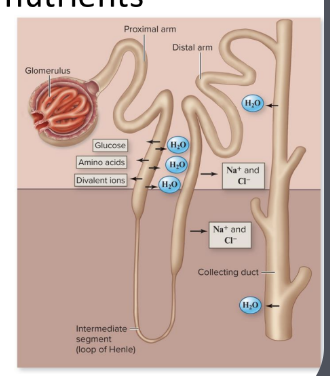
In mammals we have various structures that facilitate the excretory system:
Kidneys have Nephrons which function in secretion and filtration and a glomerulus that is the first site for filtratio n
Nephrons have a Bowmans Capsule, Proximal Tube, Loop of Henle, Distal Tube, and the Collecting Duct
The Bowmans Capsule (surrounds glomerulus):
The main site of filtration in the Nephron
The Proximal Tube:
Main site of reabsorption
Reabsorbs water, ions, salts, and nutrients
Secretes toxins into filtrate, nitrogenous waste
Loop of Henle:
Main site of the reabsorption of WATER ONLY
Function in the maintenance of the osmotic gradient
Length correlates with the concentration of urine, longer loops are associated with more concentrated urine due to increased reabsorption capabilities.
Distal Tube:
Main site of further reabsorption of water and solutes such as ions of filtrate before excretion in collecting duct
Collecting Duct:
Main site for the final excretion of filtrate in the form of urine
Every part of the nephron functions in water reabsorption
Compare water conservation strategies in animals.
Terrestrial Organisms:
Desert mammals: mainly hypertonic urine and their nephrons maintain a steep osmotic gradient
Freshwater mammals: shorter nephron loops and a lower urine concentration
Birds: produce uric acid allowing for higher water efficiency
Aquatic Organisms:
Freshwater fish: excrete large volumes of dilute urine and conserve solutes through reabsorption of ions from filtrate
Marine fish: filtration levels are low so little urine production, chloride cell’s gills help in salt balance maintenance
Compare gas exchange structures in different animal systems.
Gas exchange in water
Water has less O2 than in air
It’s facilitated by simple diffusion
Gills increase surface are increasing efficiency
Ex. Fish, Sharks, Mollusks, Crustaceans
In Fish countercurrent flow maximizes oxygen absorption by allowing water to flow in the opposite direction to the blood flow, enhancing the gradient for oxygen transfer.
Gas exchange on land
Insects
Have tracheae (air tubes) branching within the body
Deliver oxygen and co2 transfer
Separate from circulatory system
Hemolymph distributes nutrients and collects waste
Tetrapods
Lungs are primary/sole gas exchange organ
Explore different ways that animals breathe.
Breathing: maintains high O2 and low CO2 at respiratory surface
Differences in structure and efficiency
Amphibians
Lower lung surface area than amniotes
Use positive pressure breath, like filling a ballon with helium forcing air into a structure
Lowers floor of throat, contracts throat muscles
Push air from mouths to lungs and gas exchange occurs
Birds
Air sacs (bellows) keep air flowing
2 cycles of inhalation/exhalation to complete air circuit
Creates unidirectional flow of air in the lungs
Gradient of lungs favor new air coming in
Prevents mixing of old air and new air
Mammals
Negative pressure breathing, ensures high rates of oxygen delivery
Muscular contractions expand thoracic cavity, gives our body more space
Change in space causes lower pressure in lungs
Air rushes in -inhalation
Muscles relax and you breath out
Causes volume of thoracic cavity to reduce
Air is forced out through exhalation
Describe how the structure of hemoglobin helps maximize distribution of oxygen in mammals.
Hemoglobin
4 Subunits each having a heme group with an iron atom
Each iron atom binds 1 Oxygen molecule, 4 total for each heme group

Oxygen binds with iron
Binding increases affinity of hemoglobin for more O2
CO2 reduces affinity for O2 and promotes O2 unloading to tissues
Changes in blood pH decreases affinity for O2
Nearly all vertebrates expect the Antarctic block ice fish
Hemocyanin
Oxygen binds with coper
Mollusks, arthropods (basal insects)
Examine how CO2 is transported from tissues to the lungs to be removed in mammals.
CO2 is a waste product of cellular respiration
Most is converted to bicarbonate in erythrocytes, then travels in plasma to lungs
When we get to the lungs , bicarbonate is converted back to CO2, which then diffuses into the alveoli to be exhaled/removed.
Medulla Oblongata controls breathing
pH of CSF indicates CO2 level
Hydrogen from bicarbonate reaction lowers pH
Tells your body to increase breathing as metabolic activity increases
Compare open vs. closed circulation systems.
Circulatory System: Functions in distribution of O2 and nutrients and collection of CO2 and waste
Found in most animals with large or complex body plans or high metabolic needs
Animals w/o a circulatory system with a gastrovascular cavities who exchange material through diffusion, Ex. Sponges, Jellies
Open Circ. System
Organisms have a heart that’ll pump hemolymph through circulatory vessels to hemocoel
Direct delivery of resources to the tissue in hemocoel
When the heart relaxes it changes pressure in the body pulling hemolymph back into the heart
Allows waste to be filtered
Pros: Less energetically costly, Direct delivery of nutrients/waste btw. hemolymph and tissues
Cons: Lower pressure and flow rate, resource delivery is not specified to tissues/organs
Closed Circ. System
Organisms have blood confined to vessels with the heart pumping blood that branch and infiltrate tissues and organs
Exchange btw. blood, interstitial fluid, and body cells
Pressure and gradients ensure efficiency of delivery of O2 and nutrients to specific tissues
Examine differences in habitat and lifestyle of vertebrates with single vs. double circulation.
Single Circulation Organisms
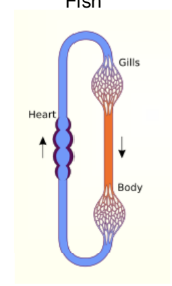
Blood passes through the heart once
Organisms have 1 atrium and 1 ventricle
Moves from heart to gills, to the body, and back to the heart
Lower blood pressure in the body
Mainly aquatic organisms
Double Circulation Organism
Blood passes through heart twice, 2 circuits
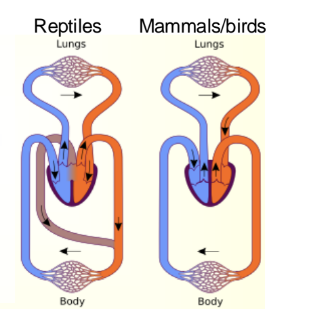
Pulmonary Circuit
Starts at the R side of the heart then O2-poor blood goes to lungs/skin, then O2-rich blood goes back to L side of heart
Systemic Circuit
Starts at L side of heart, then O2/nutrient-rich blood goes to
body, finally collect CO2-rich blood and waste goes back to R side of heart
Higher blood pressure, red blood cell returns to heart twice
Explore circulation in mammals.
Amphibians
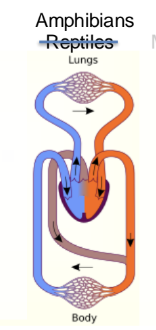
2 atria and 1 ventricle w/ a ridge
Gas exchange w/both skin and lungs
Adjust circulation when lungs are not in use
Reptiles
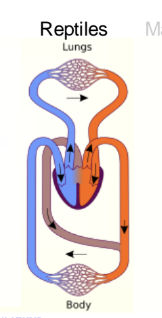
2 atria and 1 ventricle w/incomplete septum
Mixing of oxygen rich and oxygen poor blood
Can bypass pulmonary circuit when underwater
Mammals/Bird
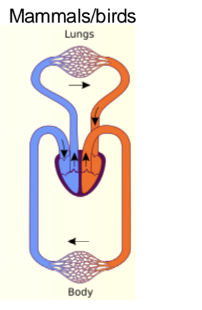
2 atria and 2 ventricles
Creates more CO2 and waste
Requires higher oxygen rate for metabolic processes, endothermy
Compare the structure and function of the three types of blood vessels.
All are have a central cavity lined by endothelium
Arteries, carry blood away from heart
THICK WALLS
Smooth muscle controls blood flow as it’s flexible
Connective tissue is strong to support high blood pressure/flow
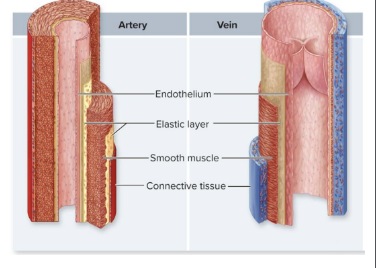
Veins, carry blood to the heart
1/3 as thick as arteries
Same tissues as arteries
Blood flows at lower pressure
Valves present to prevent backflow, maintains unidirectional flow
Capillaries, connects arteries and veins
Diameter slightly wider than red blood cell
Thin walls for gas exchange between interstitial fluid and blood
Flow varies based on organ
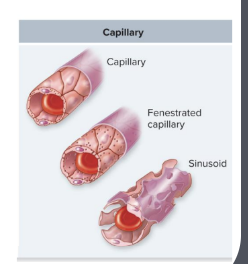
Fenestrated increases permeability
Digestion,Excretion
Sinusoid, movement of blood cells and plasma proteins
Liver, Spleen, Bone Marrow where blood cells are moving
Examine how blood pressure and flow change through circulation.
Ventricular contraction generates pressure
Generated by the hearts diastole and systole circuit
Systolic pressure
Highest pressure, ventricles contract
Lub part
Diastolic pressure
Lower pressure, arteries bounce back and heart relaxes
Dub part]
As we move away from the heart mean pressure decreases
Part is due to narrowing of blood vessels as theirs more resistance of walls of blood vessels
Blood flow: Rate or Velocity when blood enters arterioles, capillaries
LARGE VESSELS BRANCH INTO SMALLER VESSELS
Increase in TOTAL cross-sectional area decreases velocity
Ex. Garden house on regular setting water is flowing strong and really fast, when you change the head the same amount of water but pressure is not as strong
Explore the different components of vertebrate blood.
Plasma 55% of Blood
Liquid matrix where nutrients, nitrogenous waste, gases, and hormones
Dissolved ions, help buffer blood and maintain osmotic balance
Affect muscle and nerve activity
Plasma Proteins
Buffer of blood
Antibodies
Clotting factors
Erythrocytes 45% of Blood
Most numerous blood cells
Biconcave shape, increase surface area
Hemoglobin
O2 transport
Lack nuclei and mitochondria
Because the main function is to transport hemoglobin to transport CO2
Each erythrocyte transports 1 billion molecules in the body
Leukocytes <1% of Blood
5 major types
Function is to fight infection
Phagocytic removal of microbes
Immune response against unfamiliar substances
Increases in number when you’re sick
Platelets <1% of Blood
Fragments of specialized bone marrow cells
Functions as clotters, facilitates clotting (positive feedback system)
Breaks in blood vessels attracts platelets
Clotting factor is released which triggers enzyme to convert coagulant from inactive to active to patch the break
Coagulant aggregates into threads forming a clotting structure
Define countercurrent exchange and its applications in thermoregulation, osmoregulation, and excretion.
Countercurrent exchange
Transfer for some property btw. two bodies flowing in opposite directions
Ex. Water, Heat, and Oxygen
Bodies are vessels containing blood, filtrate or other secretion
This process takes advantage of gradients to move from a high conc. to a low. conc. (passive transport)
This is a continuous and slow gradient to maintain and maximize efficiency
Examine how countercurrent change can support thermoregulation, osmoregulation, and excretion
Water < O2 than air
Gills have larger SA for gas exchange
Can be maximized by countercurrent flow by:
Creating a gradient ensures increase in diffusion rate of gases btw. blood and gills
In countercurrent flow oxygen rich water flow one way why blood moves another way gaining oxygen along gradient.
If we had concurrent flow, the efficiency of oxygen uptake would significantly decrease, as the blood and water would be moving in the same direction, leading to less optimal gas exchange.
There would be a point of equilibrium as their be no increase of oxygenation of the blood
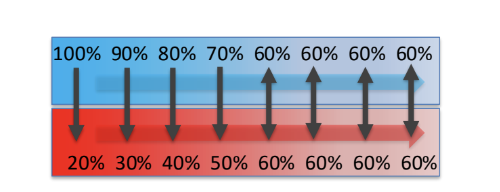
In Heat Exchange
Warm blood in arteries, cool blood in veins

Blood flows in opposite direction so heat can be transfered btw. the structures
Helps reduce heat loss in limbs
Passively conserve metabolic heat
In the Nephron
Mammals produce hyperosmotic urine to reduce water loss
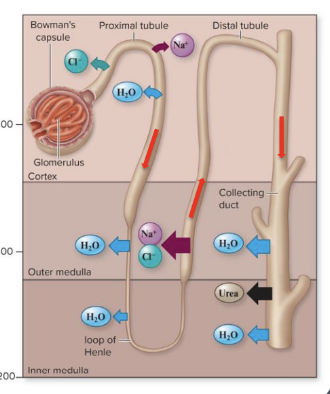
Relies on countercurrent flow of filtrate and blood=osmotic gradient
Osmotic gradient maintained by active transport of salt
Water and salt move in opposite directions
Very energetically costly
WATER IS ALWAYS PASSIVELY TRANSPORTED
Trace the exchange of gases, nutrients, and wastes across various organs and tissues.
